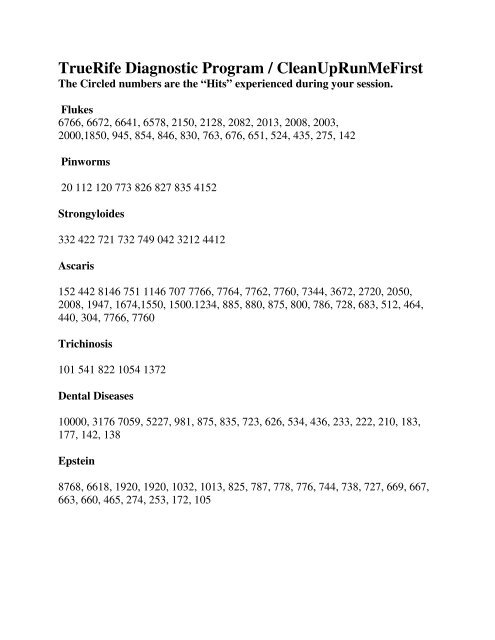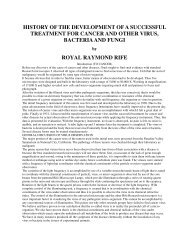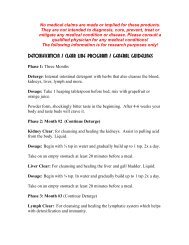TrueRife Diagnostic Program / CleanUpRunMeFirst
TrueRife Diagnostic Program / CleanUpRunMeFirst
TrueRife Diagnostic Program / CleanUpRunMeFirst
You also want an ePaper? Increase the reach of your titles
YUMPU automatically turns print PDFs into web optimized ePapers that Google loves.
<strong>TrueRife</strong> <strong>Diagnostic</strong> <strong>Program</strong> / <strong>CleanUpRunMeFirst</strong>The Circled numbers are the “Hits” experienced during your session.Flukes6766, 6672, 6641, 6578, 2150, 2128, 2082, 2013, 2008, 2003,2000,1850, 945, 854, 846, 830, 763, 676, 651, 524, 435, 275, 142Pinworms20 112 120 773 826 827 835 4152Strongyloides332 422 721 732 749 042 3212 4412Ascaris152 442 8146 751 1146 707 7766, 7764, 7762, 7760, 7344, 3672, 2720, 2050,2008, 1947, 1674,1550, 1500.1234, 885, 880, 875, 800, 786, 728, 683, 512, 464,440, 304, 7766, 7760Trichinosis101 541 822 1054 1372Dental Diseases10000, 3176 7059, 5227, 981, 875, 835, 723, 626, 534, 436, 233, 222, 210, 183,177, 142, 138Epstein8768, 6618, 1920, 1920, 1032, 1013, 825, 787, 778, 776, 744, 738, 727, 669, 667,663, 660, 465, 274, 253, 172, 105
PARASITES: Food and water are the most common sources of parasitetransmission. Since most of us eat three times a day and drink water frequentlythroughout the day, our exposure to these sources is constant. Tap water has beenfound to be contaminated with parasitic organisms. Both plant and animal foodscarry parasites, and cleaning and cooking methods often do not destroy thembefore ingestion. The CDC (Center for Disease Control) cites food as the catalystbehind 80 percent of the pathogenic outbreaks in the U.S. Most are linked torestaurants and delis where less than sanitary conditions exist -- from foodpreparation and storage to the utensils and servers' hands.Flukes: Schistosomiasis infection is contracted when a humancomes in contact with the parasite in contaminated water. Theparasite penetrates the skin and then enters the blood stream. Ifit reaches the liver, it can continue to grow in the human host.After a period of development, it migrates to the gut or bladderand begins producing eggs.Symptoms of schistosomiasis appear in three distinct phases. In the initial phase,symptoms include: fever, skin rash, abdominal pain, bronchitis, enlargement of theliver and spleen, and diarrhea. In the intermediate phase, symptoms includepathological changes in the intestinal and urinary tracts, and eggs in the urine andfeces. The final phase results in complications involving major bodily systems.Pinworms: Pinworm, also called threadworm, is a smallroundworm. Pinworms are parasites. That is, they live in thebody of other animals. They are about 3/8 inch (9 millimeters)long and have white bodies and pointed tails. Some pinwormsinfect horses and rabbits. One type, Enterobius vermicularis,commonly infects humans.The young worms live in the upper part of the large intestine. When the femalesare ready to lay eggs, they crawl down the rectum and out the intestinal openingcalled the anus, usually at night. They lay eggs on the surrounding skin. Thismovement causes skin swellings and severe itching. The eggs fall off onto thebedding or clothing, or may be picked up under fingernails in scratching. If theeggs are swallowed, they reach the intestine and become adult pinworms.Pinworms are not very harmful unless they are present in large numbers. But theireggs may infect other people or reinfect the original carrier. In some areas, 10 to 60
per cent of the children may have pinworms at some time. Doctors use drugs totreat infection caused by pinworms.If the bowel contains partially digested protein it can harbour a huge variety ofharmful bacteria and parasites. Intestinal worms outrank cancer as mankind'sdeadliest enemy worldwide and 1 in 6 of us has one or more parasites.They enter the body through contaminated food or water and it the intestinal florais imbalanced and the colon is dirty and pocketed it will become a breedingground, just as a waste dump is a perfect breeding ground for rats. Symptoms ofparasitic infection include:• pain • constipation • teeth grinding• nausea • joint & muscle pains • gas & bloating• vomiting • allergies • anaemia• chronic diarrhea • granuloma • skin conditions• anal itching • nervousness • sleep disturbances• chronic fatigueParasites can damage the body in several ways. They destroy body cells faster thanthey can be regenerated leading to perforation, ulceration and anaemia. Theysecrete toxic substances which stimulate the immune system and can produceallergic type reactions and cause pain and inflammation. Depending on their sizethey can actually obstruct certain organs – particularly the intestine, pancreas andbile ducts. In this instance, a liver flush using plenty of flax seed oil would be veryhelpful.Encysted parasites can put pressure on the brain causing a wide range of emotionaland neurological symptoms. For example, pin worms in children can causeirritability, insomnia, the inability to concentrate, mood swings, unruly behaviour,impatience, impulsiveness, aggression and a short attention span – all provoked byan allergic response to the parasite. In adults, personality changes have been notedin those with chronic toxoplasmosis, exacerbated by the duration of the infection.
Strongyloides stercoralis is an unusual "parasite" in that it hasboth free-living and parasitic life cycles. In the parasitic lifecycle, female worms are found in the superficial tissues of thehuman small intestine; there are apparently no parasitic males.The female worms produce larvae parthenogenically (withoutfertilization), and the larvae are passed in the host's feces. Thepresence of nematode larvae in a fecal sample is characteristic ofstrongylodiasis. Once passed in the feces, some of the larvae develop into "freeliving"larvae, while others develop into "parasitic" larvae. The "free-living" larvaewill complete their development in the soil and mature into free-living males andfemales. The free-living males and females mate, produce more larvae, and (asabove) some of these larvae will develop into "free-living" larvae, while other willdevelop into "parasitic larvae." As one might imagine, this free-living life cycleconstitutes an important reservoir for human infections.The "parasitic" larvae infect the human host by penetrating the skin The larvaemigrate to the lungs, via the circulatory system, penetrate the alveoli into the smallbronchioles, and they are "coughed up" and swallowed. Once they return to thesmall intestine, the larvae mature into parasitic females.Ascaris lumbricoides is one of the largest and most commonparasites found in humans. The adult females of this species canmeasure up to 18 inches long (males are generally shorter), andit is estimated that 25% of the world's population is infected withthis nematode. The adult worms live in the small intestine andeggs are passed in the feces. A single female can produce#up to 200,000 eggs eachday! About two weeks after passage in the feces the eggs contain an infectivelarval or juvenile stage, and humans are infected when they ingest such infectiveeggs. The eggs hatch in the small intestine, the juvenile penetrates the smallintestine and enters the circulatory system, and eventually the juvenile worm entersthe lungs. In the lungs the juvenile worm leaves the circulatory system and entersthe air passages of the lungs. The juvenile worm then migrates up the air passagesinto the pharynx where it is swallowed, and once in the small intestine the juvenilegrows into an adult worm. Why Ascaris undergoes such a migration through thebody to only end up where it started is unknown. Such a migration is not unique toAscaris, as its close relatives undergo a similar migration in the bodies of theirhosts (view diagram of the life cycle).#Ascaris infections in humans can cause significant pathology. The migration ofthe larvae through the lungs causes the blood vessels of the lungs to hemorrhage,
and there is an inflammatory response accompanied by edema. The resultingaccumulation of fluids in the lungs results in "ascaris pneumonia," and this can befatal. The large size of the adult worms also presents problems, especially if theworms physically block the gastrointestinal tract. Ascaris is notorious for itsreputation to migrate within the small intestine, and when a large worm begins tomigrate there is not much that can stop it. Instances have been reported in whichAscaris have migrated into and blocked the bile or pancreatic duct or in which theworms have penetrated the small intestine resulting in acute (and fatal) peritonitis.Ascaris seems to be especially sensitive to anesthetics, and numerous cases havebeen documented where patients in surgical recovery rooms have had wormsmigrate from the small intestine, through the stomach, and out the patient's nose ormouth.Ascaris suum is found in pigs. Its life cycle is identical to that of A. lumbricoides.If a human ingests eggs of A. suum the larvae will migrate to the lungs and die.This can cause a particularly serious form of "ascaris pneumonia." Adult worms ofthis species do not develop in the human's intestine.Infections of Ascaris are diagnosed by finding characteristic eggs in the feces ofthe infected host.Trichinellosis, also called trichinosis, is caused by eating raw orundercooked meat of animals infected with the larvae of a species ofworm called Trichinella. Infection occurs commonly in certain wildcarnivorous (meat-eating) animals but may also occur in domesticpigs.What are the symptoms of a trichinellosis infection?Nausea, diarrhea, vomiting, fatigue, fever, and abdominal discomfort are the firstsymptoms of trichinellosis. Headaches, fevers, chills, cough, eye swelling, achingjoints and muscle pains, itchy skin, diarrhea, or constipation follow the firstsymptoms. If the infection is heavy, patients may experience difficultycoordinating movements, and have heart and breathing problems. In severe cases,death can occur.For mild to moderate infections, most symptoms subside within a few months.Fatigue, weakness, and diarrhea may last for months.
Epstein-Barr virus, frequently referred to as EBV, is a member ofthe herpes virus family and one of the most common human viruses.The virus occurs worldwide, and most people become infected withEBV sometime during their lives. In the United States, as many as95% of adults between 35 and 40 years of age have been infected.Infants become susceptible to EBV as soon as maternal antibody protection(present at birth) disappears. Many children become infected with EBV, and theseinfections usually cause no symptoms or are indistinguishable from the other mild,brief illnesses of childhood. In the United States and in other developed countries,many persons are not infected with EBV in their childhood years. When infectionwith EBV occurs during adolescence or young adulthood, it causes infectiousmononucleosis 35% to 50% of the time.The clinical diagnosis of infectious mononucleosis (EBV) is suggested on the basisof the symptoms of fever, sore throat, swollen lymph glands, and the age of thepatient. Usually, laboratory tests are needed for confirmation. Serologic results forpersons with infectious mononucleosis include an elevated white blood cell count,an increased percentage of certain atypical white blood cells, and a positivereaction to a "mono spot" test.There is no specific treatment for infectious mononucleosis, other than treating thesymptoms. No antiviral drugs or vaccines are available. Some physicians haveprescribed a 5-day course of steroids to control the swelling of the throat andtonsils. The use of steroids has also been reported to decrease the overall lengthand severity of illness, but these reports have not been published.
Adenovirus#Virus released by mites that can cause colds#Run this program once a month September through February to prevent colds#Clinical features: Adenoviruses most commonly cause respiratory illness;however, depending on the infecting serotype, they may also cause various otherillnesses, such as gastroenteritis, conjunctivitis, cystitis, and rash illness.Symptoms of respiratory illness caused by adenovirus infection range from thecommon cold syndrome to pneumonia, croup, and bronchitis. Patients withcompromised immune systems are especially susceptible to severe complicationsof adenovirus infection. Acute respiratory disease (ARD), first recognized amongmilitary recruits during World War II, can be caused by adenovirus infectionsduring conditions of crowding and stress.#The viruses: Adenoviruses are medium-sized (90-100 nm), nonenvelopedicosohedral viruses containing double-stranded DNA. There are 49immunologically distinct types (6 subgenera: A through F) that can cause humaninfections. Adenoviruses are unusually stable to chemical or physical agents andadverse pH conditions, allowing for prolonged survival outside of the body.#Epidemiologic features: Although epidemiologic characteristics of theadenoviruses vary by type, all are transmitted by direct contact, fecal-oraltransmission, and occasionally waterborne transmission. Some types are capable ofestablishing persistent asymptomatic infections in tonsils, adenoids, and intestinesof infected hosts, and shedding can occur for months or years. Some adenoviruses(e.g., serotypes 1, 2, 5, and 6) have been shown to be endemic in parts of the worldwhere they have been studied, and infection is usually acquired during childhood.Outbreaks of adenovirus-associated respiratory disease have been more common inthe late winter, spring, and early summer; however, adenovirus infections canoccur throughout the year.
#What kind of germ is Clostridium botulinum?#Clostridium botulinum is the name of a group of bacteria commonly found in soil.These rod-shaped organisms grow best in low oxygen conditions. The bacteriaform spores which allow them to survive in a dormant state until exposed toconditions that can support their growth. There are seven types of botulism toxindesignated by the letters A through G; only types A, B, E and F cause illness inhumans.#How common is botulism?#In the United States an average of 110 cases of botulism are reported each year.Of these, approximately 25% are foodborne, 72% are infant botulism, and the restare wound botulism. Outbreaks of foodborne botulism involving two or morepersons occur most years and usually caused by eating contaminated home-cannedfoods. The number of cases of foodborne and infant botulism has changed little inrecent years, but wound botulism has increased because of the use of black-tarheroin, especially in California.#What are the symptoms of botulism?#The classic symptoms of botulism include double vision, blurred vision, droopingeyelids, slurred speech, difficulty swallowing, dry mouth, and muscle weakness.Infants with botulism appear lethargic, feed poorly, are constipated, and have aweak cry and poor muscle tone. These are all symptoms of the muscle paralysiscaused by the bacterial toxin. If untreated, these symptoms may progress to causeparalysis of the arms, legs, trunk and respiratory muscles. In foodborne botulism,symptoms generally begin 18 to 36 hours after eating a contaminated food, butthey can occur as early as 6 hours or as late as 10 days.#Caused by clostridium tetani.#Tetanus [TET-nus] is a condition that affects the nervous system and causespainful, uncontrolled muscle spasms. People get #tetanus when spores of thetetanus bacteria enter the body through an open wound and produce a powerfulnerve poison.#Tetanus spores are found throughout the environment, usually in soil, dust, andanimal waste.
Nanobacterium#The Virus and the Vaccine is the true story of a cancer-causing monkey virus,contaminated polio vaccine, and the millions of Americans exposed.#In the age of AIDS, SARS, Avian Flu, and Ebola, here is a real-life, rivetingaccount of a carcinogenic monkey virus that contaminated America’s most reveredvaccine and the cancers it is causing today.#Jonas Salk's polio vaccine has taken on legendary quality as a medical miracle,for it largely eradicated one of the most feared diseases of the twentieth century.But the story of the vaccine has a dark side, one that has never been fully toldbefore. In one of modern medicine’s biggest blunders, between 1954 and 1963, 98million Americans received polio vaccinations widely contaminated with acarcinogenic monkey virus, known as simian virus 40, or SV40. A concertedgovernment effort downplayed the incident, and it was generally accepted thatalthough oncogenic to laboratory animals, SV40 was harmless to humans.#But now SV40 is showing up in a variety of human lung, brain, bone, andlymphatic cancers in adults. It is also appearing in the cancers of some children tooyoung to have received the contaminated Salk vaccine.#Nanobacteria sanguineum is an extremely nasty organism that severelycompromises your immune system. Most people tested are infected with it. Almostanyone who has been vaccinated has it because the cow serum used to makevaccines has been contaminated. It will pass through the placenta so you have it ifyour mother was infected. Antibiotics are useless, with the exception oftetracycline. However, because of its ability to surround itself with a calcium shellwhen attacked, even tetracyline can't get at most of it.#The organism is pleomorphic (has many forms) and I have identified thefrequencies in the F100 program below. Even a healthy infected person can usethese frequencies for 45 minutes. With a moderately suppressed immune system,several hours may be required. A severly suppressed immune system may require10 hours.#Infected people may notice a profound effect from the frequencies in the programbelow. It will improve the functioning of the immune system by at least a factor ofthree.
# This bacterium is suspected to have a cancer connection.#Many studies have reported the presence of simian virus 40 (SV40)deoxyribonucleic acid (DNA) or protein in human brain tumors and bone cancers,malignant mesothelioma, and non-Hodgkin's lymphoma. However, the smallsamples and lack of control groups in some reports have made it difficult to assesstheir reliability.#Results#Thirteen studies fulfilled the criteria for the investigation of primary brain cancers(661 tumors and 482 control samples). Specimens from patients with brain tumorswere almost four times more likely to have evidence of SV40 infection than werethose from controls (odds ratio [OR] = 3.9; 95% confidence interval [CI]: 2.6 to5.8). The association was even stronger for mesothelioma (OR = 17; 95% CI: 10 to28; based on 15 studies with 528 mesothelioma samples and 468 control samples)and for bone cancer (OR = 25; 95% CI: 6.8 to 88; based on four studies with 303cancers and 121 control samples). SV40 DNA was also more frequent in samplesfrom patients with non-Hodgkin's lymphoma (OR = 5.4; 95% CI: 3.1 to 9.3; basedon three studies with 301 cases and 578 control samples) than from controls.#Conclusion#These results establish that SV40 is associated significantly with brain tumors,bone cancers, malignant mesothelioma, and non-Hodgkin's lymphoma. Studies areneeded to assess current prevalence of SV40 infections.#Nanobacterium 2#New frequencies have been found for another strain of nanobacteria. Anyone whohas used the previous set needs to use the new set as well. The effects are dramaticif you are infected with it.#Recently, while working with a blood sample of lymphocytes that were notfunctioning properly, I tested the leukocyte to find out why it was sitting there fat,dumb, and happy, when it should have been eating pathogens. The cell appeared tobe in perfect condition. The environment around the cell was fine. The culprit wasthe little organism in the cell wall pointed to by the arrow in the picture. Thisappears to be a nanobacteria and it had completely shut down the functioning of anotherwise healthy leukocyte.
#Nanobacteria sanguineum is an extremely nasty organism that severelycompromises your immune system. Most people I have tested are infected with it.Almost anyone who has been vaccinated has it because the cow serum used tomake vaccines has been contaminated. It will pass through the placenta so youhave it if your mother was infected. Antibiotics are useless, with the exception oftetracycline. However, because of its ability to surround itself with a calcium shellwhen attacked, even tetracyline can't get at most of it.#The organism is pleomorphic (has many forms) and I have identified thefrequencies in the F100 program below. Even a healthy infected person can usethese frequencies for 45 minutes. With a moderately suppressed immune system,several hours are required. A severly suppressed immune system may require 10hours.#Infected people may notice a profound effect from the frequencies in theprograms below. It will improve the functioning of the immune system by at least afactor of four.#Some people who have suggested that cholesterol buildup in the arteries is theresult of nanobacteria. It may be that cholesterol is a response to the inflammationof the arteries now known to create problems is caused by nanobacteria, as well asother pathogens. It would explain why chelation therapy seems to work becausethe EDTA clears out calcium in the arteries that may be deposits from shellsformed by nanobacteria. My tests indicate it would be wise to take oral EDTAcapsules when using these frequencies.#If nanobacteria is distroyed does arterial plaque buildup go away? This is left as aresearch project for the reader. Followup and lab tests are essential to prove thisone way or the other. What has definitely been experienced by infected peopleusing these frequencies is an enhanced immune system, an increase in energy, anddecreased need for sleep. In one case they turned a teenager whose long termsurvival was at stake into a normal energetic teenager overnight.
Bacillus Lichenformis#The first step in dealing with cancer electronically must be to eliminate allBacillus Lichenformis from the body as it appears to be both a tumor promoter anda mutagen. Tumors will tend to grow or recur with this organism present. Also, anysignificant infection with this organism depresses the immune system and severelydrains energy from the body, possibly one of the main reasons that newlydiagnosed cancer patients often deteriorate so rapidly. Most people with adepressed immune system are infected with nanobacteria and that must beeliminated also.#Infected individuals should run this F100 program weekly for as long and as oftenas it takes to eliminate any detectable Bacillus Licheniformis. Multiple treatmentswill be required as this is a very persistence organism.CMV#CMV is a common virus that infects most people at some time during their livesbut rarely causes obvious illness. It is a member of the herpes virus family. Othermembers of the herpes virus family cause chickenpox, infectious mononucleosis,fever blisters (herpes I) and genital herpes (herpes II) . Like other herpes viruses,CMV infection can become dormant for a while and may reactivate at a later time.The virus is carried by people and is not associated with food, water or animals.#Most children and adults who are infected with CMV do not develop symptoms.Those who develop symptoms may experience an illness resembling infectiousmononucleosis and have fever, swollen glands and feel tired. People with acompromised immune system (such as AIDS patients or those receivingchemotherapy) may experience more serious illness involving fever, pneumoniaand other symptoms.Stabilize Immune SystemResonant frequency therapy to assist in immune system stabilization. Excellent toaddress a host of immunological conditions. Arthritis, Poison Ivy, Allergies,Lupus, MS, etcAsk for this program for immune system stabilization.













